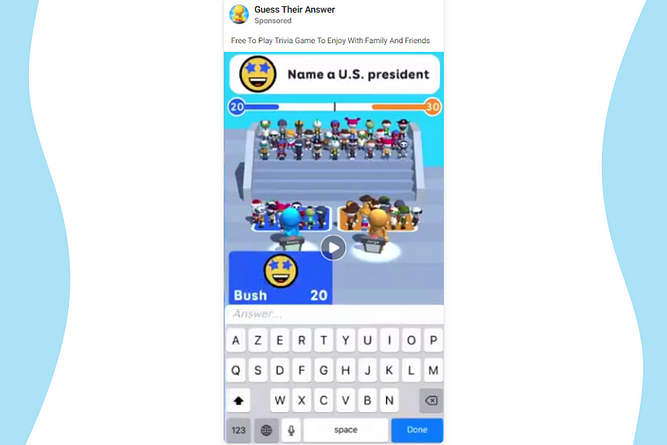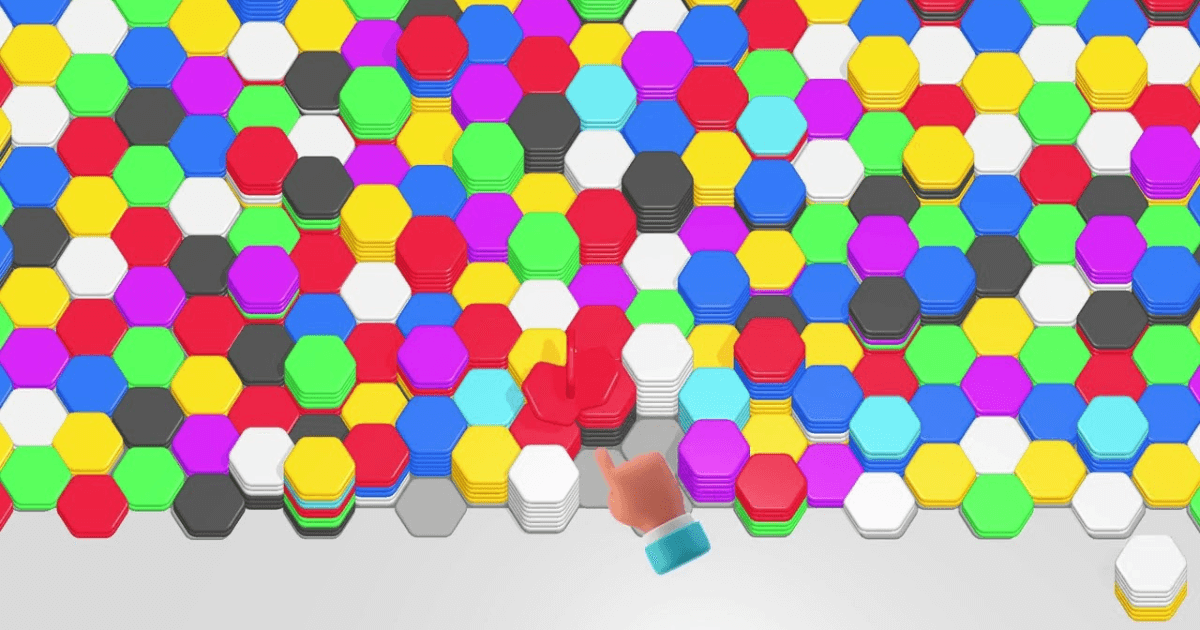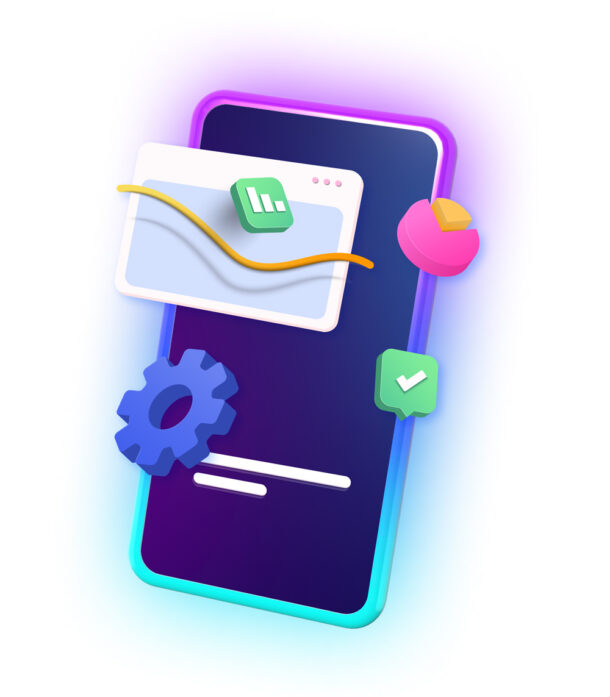With 2.94 billion monthly active users, Facebook (Meta) is one of the best ad networks to promote mobile games.
Whether you’ve been doing it for years, or you’re about to advertise your first game on Facebook, this article can help you do better.
During years in the business, we’ve noticed that a lot of game advertisers tend to make the same, easy-to-avoid Facebook ad mistakes.
Don’t be one of them.
Here is a list of 10 common Facebook ad mistakes you should steer clear of when promoting a mobile game.
1. Starting Before Determining KPIs
KPIs (key performance indicators) are the ultimate starting point in the mobile gaming universe. Just like you need to define them when developing, publishing, and monetizing a game, you have to do the same when advertising it.
This is the ONLY way to know how successful your campaigns are.
If you don’t define KPIs, you won’t be aware if your campaigns are too expensive, if you should optimize them, what you can aim for in the future, etc.
Before deciding on your Facebook KPIs, ask yourself: “What do I want to achieve by advertising this game?”
Is it getting a bunch of downloads in a short time, finding low-cost players, finding quality players, or something else?
Once you have your priorities sorted, carefully think about which KPIs can help you achieve your goals. To help you decide, here’s a list of some of the most common KPIs that marketers track when advertising a mobile game on social media:
- CPI (cost per install)
- ROI (return on investment)
- Installs
- Retention rates
- LTVs (lifetime values)
2. Not Tracking Enough KPIs
When it comes to KPIs, another common mistake is tracking too few of them. For example, a lot of marketers focus on CPI only
They make CPI their holy grail and ignore other vital metrics.
Sure, it is important to know how much it costs to acquire users. However, many marketers are unaware that there are various KPIs that can help them understand this:
- CPI – the price you pay for one user to install the game
- CPA (cost per acquisition) – the cost of acquiring a user that performs a certain action after the install
- CAC (customer acquisition cost) – the overall amount of money spent to get a new user, including both organic and paid UA methods
What’s the point of tracking all these similar KPIs?
Each one of them is more or less granular. If you track only one of them, you won’t have the full picture of your advertising performance. For this reason, it’s important to track multiple relevant KPIs.
3. Setting an Inadequate Budget
Budgeting is always tricky.
Therefore, it’s not surprising that one of the most common Facebook ad mistakes is setting the ad budget too high or too low
If you set the budget too low, you’re limiting your campaign reach. As a result, your data pool is insufficient to make conclusions. For example, if 10 people install your game from your low-budget campaign, and 8 of them are female, you can’t conclude that this is your game’s target audience.
As unusual as it may sound, there is also such a thing as too high of a budget. It’s a mistake to start advertising a game with a huge budget because you can spend it in a blink of an eye and achieve nothing
So how can you avoid making these Facebook ad mistakes?
According to Meta, the minimum daily budget should be 5x higher than your cost-per-result goal. For instance, if you set a maximum of $5 CPA, your minimum daily budget should be $25.
Note that this is not something set in stone – it’s just a good starting point. Once you have the results from your first campaigns, you should start testing different daily budgets.
Once you reach the point where your campaign works well, and you’ve found your ideal CPI or CPA, you will probably feel the urge to go “all in”.
However, you shouldn’t be increasing your budget too much in one day. It’s a better idea to increase it gradually – 5% to 10% per day. In case you drastically increase the budget at once, Meta will assume you have a lot of money to “waste.”
4. Not Collecting Organic Data First
This is a common mistake that games advertisers tend to make at the start of their Facebook journey.
They rush things.
After creating an app ID on Facebook and adding the Facebook SDK to the game, they want to launch some paid UA campaigns right away.
We understand the urge.

Steps for promoting an app on Facebook. Source: Facebook Business Solutions
But, instead of doing this immediately, it would be good to give Facebook’s algorithm at least two weeks to get to know your game and its audience. The algorithm can then make use of the available organic data to help you improve targeting and make the most of your Facebook ad budget.
What happens when you finally launch your campaigns?
A learning phase.
Whenever you launch a new campaign, the ad sets within it go through a learning phase. This is a period in which Meta’s algorithm still has a lot to learn about the ad sets. In this phase, performance is typically unstable (eg high CPI).
The learning phase lasts until your ad sets get at least 50 optimization events, i.e. installs. Until this happens, you can’t consider the campaign results valid.
5. Making Assumptions About Your Audience
Speaking of targeting, one of the most frequent Facebook ad mistakes is going after the wrong audience.
How many times have you seen ads for games that you didn’t find interesting?
We’ve seen plenty.
This happens because advertisers frequently think they have a good idea of a game’s target audience. For example, they assume that only teenage males play shooter games, and only young women play home decoration games. In reality, the age and gender distribution of your audience can be much different.
Without data on this, you’re just speculating.
For this reason, you should keep things open.
If you’re lacking audience demographics data, run some test campaigns on Android (due to iOS privacy restrictions). Make sure that these campaigns have a broad reach, set up a sufficient budget, and let them roll for a while.
When the test ends, all that’s left to do is to analyze all the valuable data you gathered.
To do this, head to the Breakdowns in the Ads Manager. There, you’ll be able to find the age, gender, platform, device, and location of users who installed your game.
When it comes to finding the best audience for your game, we recommend you prioritize Advantage + app campaigns (formerly Automated App Ads). This campaign type uses powerful machine learning to deliver the right ads to the right audience.
6. Displaying Ads to Users Who Already Installed the Game
If a user already installed your game, make sure they don’t see more ads inviting them to do so.
This is how money goes down the drain.
You can simply prevent this from happening by using Facebook’s exclusions targeting feature.
If you want to approach these users again, the right way to do it is through retargeting campaigns. For example, you can create separate campaigns to reach users who haven’t used the app for a while. Or you can try to drive in-app purchases by advertising special deals to active users.
7. Not Optimizing Lookalike Audiences
Most of the above-mentioned Facebook ad mistakes usually happen to beginners.
With this one, that’s not the case.
Even experienced mobile game marketers make the mistake of not updating lookalike audiences.
Facebook’s lookalike audiences are one of its most important targeting options. This option allows you to find users that are similar to your audience (eg by demographics or interests).
Most game advertisers use this option all the time.
Yet, a lot of them are missing out on its full potential.
When creating lookalike audiences, you can adjust their size range based on the source event (eg app installs). In this phase, you want to collect as much data on your lookalike audiences so that you can go pretty broad.
Once you gather enough data about lookalike audiences, it’s time to update them. You can do that by following these four steps:
- decrease size range to attract smaller, but more similar lookalike audiences
- change the lookalike audience source from “app installs” to “app opens”
- identify users who open your game and use it frequently
- create a custom lookalike audience based on step 3)
8. Poor Ad Messaging
Facebook ads consist of an ad creative, primary text, headline, description, and a CTA.
We’ve seen game marketers screw up each of these.
For example, we frequently stumble upon primary texts that are too long or too short. A good rule of thumb is to keep them 3–5 sentences long. Also, since games are all about fun, don’t be super official – emojis are welcome.
When it comes to creating a headline, don’t approach it like rocket science. The headline should simply feature the main point of your ad. You should be able to wrap this up into 5 words max.

Example of a Facebook ad with a short primary text and no CTA button. Source: Meta Ad Library
Finally, some game marketers even misuse CTAs. They either don’t use one or make the wrong choice. For example, we’ve seen some advertisers choose the “Learn More” CTA to encourage game installs.
This is a bad choice because Facebook offers more suitable CTAs for mobile apps and games. These are “Play Game”, “Download”, `Install Now” and “Use App”. This is what you want your users to do after seeing your ad.
9. Bad Creative Strategy
Ad creatives are at the heart of every successful UA campaign. Based on the creatives they see, users decide if they will install the game or not.
There is a lot of room for mistakes here.
One of the biggest Facebook ad mistakes is not using video ads to promote mobile games. Video has proven to be the most efficient format for showing off a game’s features, and for catching the users’ attention.
This is only the first creative strategy mistake on a lengthy list. Here are some other ad creative mistakes you should avoid making:
- too many ads in one ad set (not separating them into multiple ad sets)
- not A / B testing ad creative concepts
- not testing ad variations (changing only one creative element)
- sticking to the same creatives for a long time
- not creating different ad dimensions
10. Not Even Considering Organic
Facebook advertising doesn’t consist of paid campaigns only. Organic advertising can also be helpful in growing your mobile game, and it’s a mistake to completely ignore its potential.
Yes, the results will come in much slower.
But if you do it properly and consistently, you won’t regret the effort.
This is especially true for games that attract active Facebook audiences. According to Statista, the majority of Facebook users are aged 25–34. If your game’s target audience falls into this group, make sure to try and reach users organically.
A lot of mobile games have their own Facebook pages. Yet, it’s not enough to just have a page. If you want to get the most out of organic advertising you need to regularly interact with your audience and listen to their feedback.

An example of great organic Facebook advertising by Homescapes
Ultimately, organic advertising can even help with your paid UA campaigns.
If you manage to build a positive community, your players might leave positive comments on your ads, increasing your reach and encouraging others to hit the install button.
Facebook Ad Mistakes: Final Thoughts
It’s not difficult to create Facebook campaigns for mobile games – this can take just a couple of minutes. The hard part is creating campaigns that don’t drain budgets and deliver quality players.
Sure, making mistakes can be an important learning experience.
Yet, you avoid making them from the start, this will save you both nerves and money. Hopefully, this list of common Facebook ad mistakes will help you on your way to great results.
But note this.
If you’ve eliminated all these Facebook ad mistakes and your campaigns are still not performing well, this ad network might not be the right fit for your game. In this case, we suggest you try out some other high-quality mobile ad networks like MAF.







